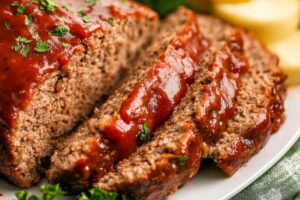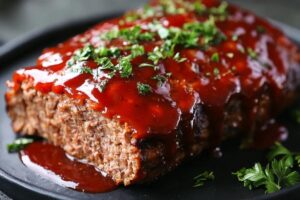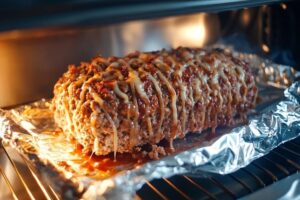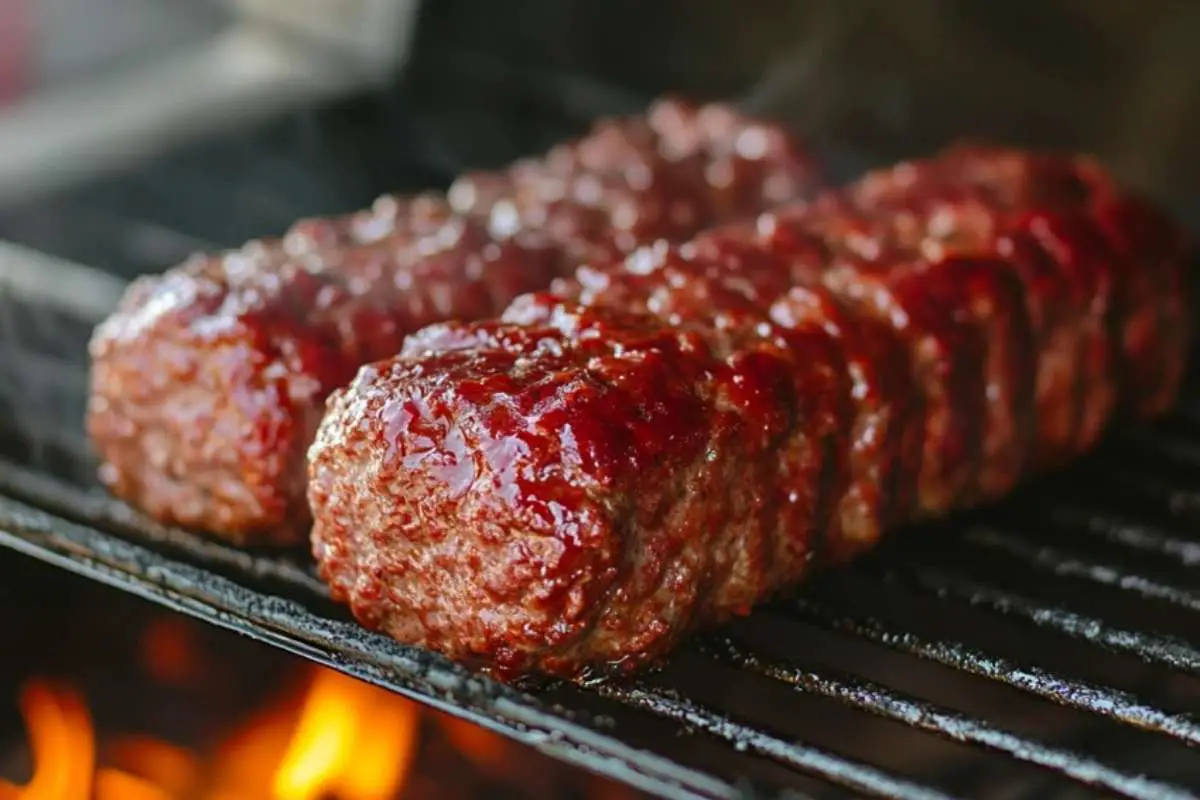Meatloaf is a beloved comfort food in American kitchens for ages. The debate is on: should you cook it at 350°F or 375°F? This article will look into the advantages and disadvantages of each temperature. It aims to help you find the best oven setting for your meatloaf.
Key Takeaways
- Cooking meatloaf at 350°F or 375°F can result in slightly different textures and cooking times.
- Factors like oven calibration, meatloaf size, and shape can impact the optimal cooking temperature.
- Considering the internal temperature and resting time is crucial for achieving a perfectly cooked meatloaf.
- Experimenting with different temperatures and techniques can help you find the perfect meatloaf recipe for your personal preferences.
- Adjusting the cooking temperature is just one aspect of creating a delicious meatloaf; variations in ingredients and serving suggestions can also elevate the dish.
What is Meatloaf?
Meatloaf is a classic American dish that brings comfort to many. It’s made from ground meat, breadcrumbs, eggs, and seasonings. These ingredients are baked in a loaf pan until golden.
A Classic Comfort Food
Meatloaf is known as a comfort food. It brings back memories of home and family. Its smell and taste make it loved by all ages.
It pairs well with mashed potatoes, green beans, or a tangy glaze. This makes it a dish that everyone can enjoy.
Ingredients and Variations
The basic meatloaf recipe uses ground beef. But, you can also use pork, turkey, or a mix. Breadcrumbs or oats help hold it together, while eggs add moisture.
Onions, garlic, and herbs add flavor. Some recipes include shredded veggies, cheese, or bacon for extra taste.
Meatloaf is very flexible. You can stick to traditional recipes or try new ones. This makes it easy to make it your own.
Understanding Oven Temperatures

Getting the perfect meatloaf starts with knowing your oven’s temperature. Different ovens, even from the same brand, can have varying temperatures. This makes it hard to find the right cooking temperature for your meatloaf.
It’s important to calibrate your oven for accurate cooking temperatures. Over time, ovens can get off track, causing your meatloaf to cook too little or too much. Using a reliable oven thermometer to check your oven’s temperature regularly is key.
The oven temperature greatly affects your meatloaf’s outcome. Higher temperatures can make the outside crispy and the inside juicy. Lower temperatures might make your meatloaf dry and less flavorful. Finding the right temperature is crucial for the perfect texture and taste.
| Oven Temperature | Meatloaf Texture | Cooking Time |
|---|---|---|
| 350°F | Tender and Juicy | 60-75 minutes |
| 375°F | Crispy Exterior, Moist Interior | 50-60 minutes |
Understanding how oven temperature, meatloaf texture, and cooking time relate can help you achieve your desired results. Try different temperatures and adjust cooking times to find what works best for you.
Factors Affecting Meatloaf Cooking Temperature
The perfect meatloaf is a delicate balance. Several factors can impact the optimal cooking temperature. These include the accuracy of your oven’s calibration, the size, and shape of the meatloaf itself. Understanding these elements is crucial for achieving mouthwatering results every time.
Oven Calibration
One of the primary considerations is the accuracy of your oven’s temperature. Even the most carefully crafted meatloaf recipe can fall short if your oven is not properly calibrated. It’s essential to periodically check the oven’s temperature using a reliable oven thermometer. This ensures that the displayed temperature matches the actual temperature inside the appliance.
Meatloaf Size and Shape
The size and shape of your meatloaf can also significantly affect the cooking time and temperature. Larger meatloaves will typically require a lower temperature and longer baking time. This ensures the interior is cooked through without overcooking the exterior. On the other hand, smaller, more compact meatloaves may benefit from a higher temperature for a quicker cook time.
- Factors affecting meatloaf cooking include oven calibration, meatloaf size, and meatloaf shape.
- Proper oven calibration is essential to ensure the displayed temperature matches the actual temperature inside the appliance.
- The size and shape of the meatloaf can impact the optimal cooking temperature and time. Larger meatloaves require lower temperatures and longer baking times.
By understanding these key factors, you can fine-tune your meatloaf cooking process. This will help you achieve the perfect texture and flavor every time.
The Pros and Cons of Cooking Meatloaf at 350°F
Cooking meatloaf at 350 degrees Fahrenheit is a common choice. It offers both benefits and drawbacks. Let’s look at the advantages and disadvantages of this temperature to help you decide.
Pros of Cooking Meatloaf at 350°F
- Consistent and Reliable Cooking: 350°F is a widely accepted temperature for meatloaf. It ensures the dish is cooked evenly and thoroughly.
- Gradual and Even Browning: At this temperature, the meatloaf browns nicely on the outside. This adds flavor and makes it look appealing.
- Tender and Juicy Texture: The slower cooking at 350°F keeps the meatloaf moist. This results in a tender and juicy final product.
Cons of Cooking Meatloaf at 350°F
- Longer Cooking Time: Meatloaf baked at 350°F takes longer to cook. This can be a problem if you’re short on time.
- Potential for Dryness: While 350°F helps keep moisture, overcooking can make the meatloaf dry and crumbly. It’s important to watch it closely.
- Limited Browning: The slow browning at 350°F might not give the same caramelization as a higher temperature.
Whether to cook your meatloaf at 350°F or a higher temperature depends on your preference and recipe. Knowing the pros and cons can help you choose the best temperature for a perfect meatloaf every time.
The Pros and Cons of Cooking Meatloaf at 375°F

Choosing the right oven temperature is key to a perfect meatloaf. While many bake at 350°F, 375°F offers unique benefits and things to consider.
Cooking at 375°F can make the meatloaf’s crust crisper and tastier. The higher heat caramelizes the outside, keeping it moist and golden. This is great for those who love a crunchy exterior.
But, there are downsides to cooking at 375°F. It cooks faster, so you must watch it closely to avoid dryness. The heat can also make the meatloaf shrink, leading to a smaller size.
| Pros of Cooking Meatloaf at 375°F | Cons of Cooking Meatloaf at 375°F |
|---|---|
|
|
Whether to cook at 375°F or 350°F depends on what you like. Some enjoy the quick cooking and crunchy crust. Others prefer a moist, tender interior. It’s important to monitor the meatloaf closely to get the results you want.
Is it better to cook meatloaf at 350 or 375?
The debate over the best oven temperature for meatloaf has been ongoing. Both 350°F and 375°F are popular, each promising moist and flavorful results. But which one is the best for meatloaf? Let’s look at the pros and cons of each to find out.
Cooking at 350°F is a favorite among many. It cooks the meat gently, making it tender and juicy. This slow cooking also prevents the outside from drying out. It’s great for larger meatloaves, ensuring even cooking.
On the other hand, 375°F is favored by some for its benefits. It creates a crispy crust on the outside while keeping the inside moist. This temperature works well for smaller meatloaves, helping to keep the juices in.
The choice between 350°F and 375°F depends on your preference and recipe. The meatloaf’s size and your desired doneness also matter. Try both temperatures and adjust cooking times to find your perfect meatloaf.
| Cooking Temperature | Pros | Cons |
|---|---|---|
| 350°F |
|
|
| 375°F |
|
|
In conclusion, the choice between 350 or 375 for meatloaf depends on your taste and recipe needs. Experiment with both temperatures to find the perfect meatloaf for you.
Tips for Perfect Meatloaf
To make the perfect meatloaf, follow these tips. Check the internal temperature and let it rest for the right amount of time. These steps can greatly improve your homemade meatloaf.
Internal Temperature Guidelines
It’s important to cook your meatloaf to the right temperature. This ensures it’s safe to eat and has the best texture. The ideal internal temperature is 160°F.
Use a meat thermometer to check the center of the loaf. Be careful not to hit bones or air pockets, as this can give a wrong reading.
Resting Time
Don’t cut into your meatloaf as soon as it comes out of the oven. Let it rest for at least 15 minutes before slicing. This step helps the juices spread evenly, making the meatloaf moist and flavorful.
By following these tips for perfect meatloaf, you’ll make a dish everyone will love. Remember to check the meatloaf internal temperature and let it rest for the right meatloaf resting time.
Meatloaf Variations and Serving Suggestions
Meatloaf is a comfort food loved by many. It can be made in many ways, from classic to creative. Let’s look at some popular types and fun ways to serve it.
Meatloaf Variations
- Classic Meatloaf: The traditional recipe featuring ground beef, breadcrumbs, eggs, and a tomato-based glaze.
- Turkey Meatloaf: A leaner alternative made with ground turkey, herbs, and spices.
- Meatloaf Cupcakes: Mini meatloaves baked in a muffin tin, perfect for individual portions.
- Bacon-Wrapped Meatloaf: A savory twist with a crispy bacon exterior.
- Cheesy Meatloaf: Stuffed with melted cheddar or mozzarella cheese for an extra indulgent experience.
Meatloaf can be served in many ways. Here are some tasty ideas to enjoy with your meatloaf:
- Serve slices of meatloaf alongside creamy mashed potatoes and roasted vegetables for a classic comfort food platter.
- Top meatloaf with a tangy barbecue or mushroom gravy for an extra flavorful experience.
- Use meatloaf as the base for a satisfying sandwich, paired with crisp lettuce, juicy tomatoes, and your choice of condiments.
- Crumble cooked meatloaf into a hearty pasta dish, such as spaghetti bolognese or macaroni and cheese.
- Slice meatloaf and serve it over a bed of mixed greens for a lighter, yet still comforting, meal.
| Meatloaf Variation | Key Ingredients | Serving Suggestion |
|---|---|---|
| Classic Meatloaf | Ground beef, breadcrumbs, eggs | Mashed potatoes and roasted vegetables |
| Turkey Meatloaf | Ground turkey, herbs, spices | Mixed green salad with balsamic dressing |
| Bacon-Wrapped Meatloaf | Ground beef, bacon | Creamy mushroom gravy and roasted potatoes |
| Cheesy Meatloaf | Ground beef, cheddar or mozzarella cheese | Garlic bread and sautéed green beans |
Meatloaf is a comforting dish that can be enjoyed in many ways. Try different meatloaf variations and meatloaf serving ideas to find your favorite.
Conclusion

In this article, we’ve looked at cooking meatloaf at 350°F and 375°F. We’ve talked about the good and bad of each method. This helps you decide and make a great meatloaf.
Whether you like 350°F or 375°F, you know how to adjust. You’ve learned about oven calibration, meatloaf size, and internal temperature. This knowledge will help you make amazing meatloaf.
Remember, the secret to great meatloaf is balance. It should be tender, juicy, and have a nice crust. Use the tips from this article to make meatloaf that everyone will love, no matter the temperature.
FAQ
Is it better to cook meatloaf at 350 or 375 degrees?
The best oven temperature for meatloaf depends on several things. These include the oven’s accuracy, the size and shape of the meatloaf, and your personal taste. Both 350°F and 375°F are common choices, each with its own benefits and drawbacks.
What is meatloaf?
Meatloaf is a beloved American dish. It’s made by baking a mix of ground meat, breadcrumbs, eggs, and spices. You can make it your own by adding different meats, veggies, herbs, and sauces.
How do oven temperatures affect meatloaf?
The oven temperature greatly affects meatloaf’s cooking time, texture, and quality. Things like the oven’s accuracy, the meatloaf’s size and shape, and the pan used all play a role in finding the best temperature.
What are the pros and cons of cooking meatloaf at 350°F?
Cooking at 350°F is a popular choice. It can make the meatloaf moist and tender. However, it might take longer to cook and could result in less browning on the outside.
What are the pros and cons of cooking meatloaf at 375°F?
Cooking at 375°F offers different benefits. It can cook the meatloaf faster and give it a nice brown crust. But, it might make the meat drier if not watched closely.
What is the recommended internal temperature for perfectly cooked meatloaf?
Meatloaf should be cooked to an internal temperature of 165°F. Use a food thermometer to check. Letting it rest for 5-10 minutes before slicing also helps keep it juicy.
What are some popular meatloaf variations and serving suggestions?
You can make meatloaf your own with various ingredients. Try different meats, veggies, herbs, and sauces. Serve it sliced, as sandwiches, or with sides like mashed potatoes or roasted veggies.

